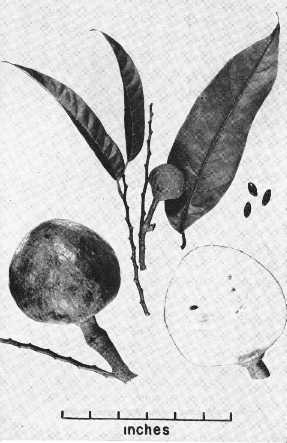Sunset®: 24-25
USDA: 10-11
Frost Tolerance: Tender in Phoenix, foliage damaged at 30° F (-1° C), serious damage at 26° F (-3° C)
Sun Exposure: Full sun to light shade
Origin: Tropical America
Growth Habits: Small evergreen tree, up to 25 feet tall (7.5 m)
Watering Needs: Regular water, not as drought resistant as the sweetsop.
Propagation: Seeds, budding
The Custard Apple, native to tropical America, is a deciduous tree 20 to 25 feet in height. The oblong to lanceolate leaves are up to 10 inches in length and are pubescent when young but smooth when mature.
This fruit is often confused with the Pond Apple, Annona glabra L., because of the similarity in fruit shape (fig. 9). The orange-colored pulp of the pond apple is inedible, but the plant does have promise as a rootstock for other annonas because of its tolerance to flooded conditions.
Blooming Habits:
The flowers are produced in the axils of the leaves on the new growth.
Fruiting Habits:
The globose-ovoid fruits are 3 to 5 inches in diameter (7-12 cm). The skin is smooth, but the surface is faintly divided into platelets showing that, botanically, the fruit has resulted from the fusion of many carpels. The skin is brownish when ripe and may be blushed with red on one cheek. In the caribbean, the fruit ripens in late summer to early fall. The pulp of the fruit is off-white and is sweet but tends to be somewhat insipid. The custard apple is one of the poorest of the annonas with respect to quality.
The Red Custard Apple is a cultivar with improved taste, altough slightly less productive.
Propagation:
The custard apple can be propagated readily from seeds; the seedlings begin producing fruit when 4 to 5 years of age. It also can be grafted or budded on seedlings of the same species, or on those of soursop, sweetsop, and pond apple. Trees of the custard apple grow well on a wide range of soil types and are better adapted to the drier regions of the Tropics than are the other annonas. They cannot tolerate excessive soil moisture.
Desert-Tropicals is dedicated to provide gardening advice, gardening ideas, and information about flower of all kind for landscape and collections.We try to check carefully the identification of the plants on the illustrations as well as the other information from the page, but occasionally errors do occur. if you notice anything that needs to be changed please contact us.Thanks.
© 1998-2020 Philippe Faucon, All Rights Reserved.
